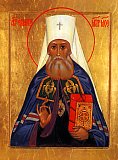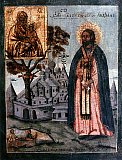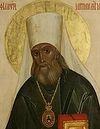

| Previous day | Next day |
| Old Style
November 19
|
Monday |
New Style
December 2
|
|
24th Week after Pentecost.
Tone 6.
Nativity Fast. |
Wine and oil allowed.
|
![]() Prophet Obadiah (Abdias) (9th c. b.c.).
Prophet Obadiah (Abdias) (9th c. b.c.). ![]() Martyr Barlaam of Caesarea in Cappadocia (304).
Martyr Barlaam of Caesarea in Cappadocia (304). ![]() Sts. Barlaam, monk, Ioasaph, prince of India, and Abenner the King, father of St. Ioasaph (4th c.).
Sts. Barlaam, monk, Ioasaph, prince of India, and Abenner the King, father of St. Ioasaph (4th c.). ![]() St. Philaret, metropolitan of Moscow (1867).
St. Philaret, metropolitan of Moscow (1867).
Martyr Heliodorus, in Pamphylia (ca. 273). Martyrs Azes of Isauria and 150 soldiers (284). Martyr Agapius of Gaza (284-305). St. Hilarion of Georgia, wonderworker of Thessalonica (875). St. Barlaam, first abbot of the Kiev Caves (1065). Uncovering of the relics of Hieromartyr Adrian, founder of Poshekhonye Monastery (Rostov) (1625). St. Ioannicius, schemaarchimandrite, of Glinsk Hermitage (1914). St. Porphyriоs of Kapsokalyvia and Kallisa (1991).
New Hieromartyrs Porphyrius (Gulevich), bishop of Simferopol, Ioasaph (Udalov), bishop of Chistopol, Michael (Kvanin), archimandrite, of Moscow, Gennadius (Rebeza), archimandrite, of Odessa, Gerasim (Sukhov), hieromonk, of Kazakhstan, Michael Dimitrev, archpriest, of Selishchi (Ryazan), John Malinovsky, archpriest, of Noviye Gorki (Ivanovo), Sergius Makhaev, archpriest, of Bogorodsk (Moscow), Constantine Mikhailovsky, archpriest, of Mordovia, James Perederiy, archpriest, of Velbovka (Kharkov), and Alexander Serebrov, archpriest, of Simbirsk (1937). New Hieromartyrs Ioasaph (Krymzin), abbot, and Peter (Mamontov), hieromonk, both of the Holy Transfiguration Guslitsky Monastery (Moscow) (1937). New Hiero-confessor Alexis (Kabaliuk), schema-archimandrite, of Khust (Carpatho-Russia) (1947).
St. Patroclus of Bourges (577). St. Egbert, archbishop of York (766). St. Simon, wonderworker of Calabria (10th c.).
Repose of Elder Cleopa of Sihastria, Romania (1998).
Thoughts for Each Day of the Year
According to the Daily Church Readings from the Word of God
By St. Theophan the Recluse

Monday. [I Tim. 5:1-10; Luke 17:20-25]
Having said that the Son of Man will appear in his day like lightning, instantly illuminating everything under heaven, the Lord added: But first must He suffer many things, and be rejected of this generation. The word order here makes it apparent that this “must suffer” should precede Lord’s appearance in glory. Thus, the whole time until that day is the time of the Lord’s suffering. He suffered in His person at one known time; after that His sufferings continue in believers—suffering as they are born, their upbringing in the spirit and protection from actions of the enemy, both inner and outer—for the Lord’s union with His own is not just mental or moral, but living. Everything that touches them is accepted by Him as well, as the head. Therefore, it is impossible not to see that the Lord indeed suffers much. The most painful sorrows are the falls of believers; even more painful for Him is when they fall away from the faith. But these are the final wounds; as continuously wounding arrows are the sorrows, temptations, and wavering faith of unbelief. Words and writings that exude unbelief are kindled arrows of the evil one. Nowadays, the evil one has led many blacksmiths to forge such arrows. The hearts of believers ache when they are struck by them and see others being struck. The Lord aches too. But the day of the Lord’s glory will appear—then all the secret darkness will be revealed, and those who have suffered will rejoice with the Lord. Until that time we must endure and pray.
Articles
 Prophet Obadiah (Abdia)The Holy Prophet Obadiah [or Abdia] is the fourth of the Twelve Minor Prophets, and he lived during the ninth century B.C. |
 Martyr Heliodorus in PamphyliaThe Holy Martyr Heliodorus lived during the reign of the emperor Aurelian (270-275) in the city of Magidum (Pamphylia). |
 Venerable Barlaam the Abbot of the Kiev Near CavesSaint Barlaam, Igumen of the Kiev Caves, lived during the eleventh century at Kiev, and was the son of an illustrious noble. |












